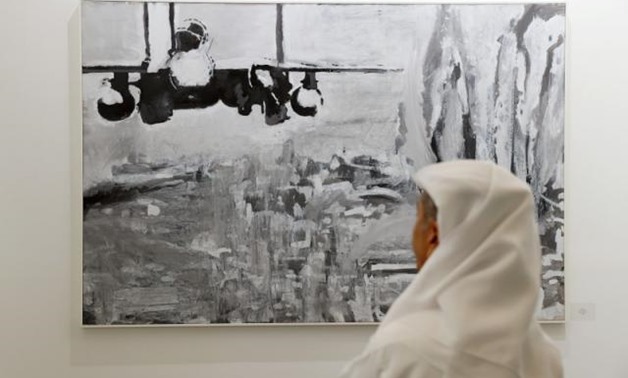
A visitor looks at artworks made by a Palestinian artist at the annual Art Dubai exhibition in Dubai, United Arab Emirates March 21, 2018. REUTERS/Ahmed Jadallah
DUBAI (Reuters) - As traditional centers of modern Arab art in Damascus and Baghdad have imploded amid disastrous wars, the sheeny city-state of Dubai in the United Arab Emirates has stepped into the vacuum as a major hub for art sales.
But at the annual Art Dubai fair this week, some Mideast artists among the scores of worldwide participants channeled in paint the chaos swirling around this bubble of calm luxury.
Tucked among the mostly apolitical photography, sculpture and installation art adorning the vast open-plan space, black-and-white paintings of war scenes in the Gaza Strip — devoid of people and any sharp detail — stand out.
“It’s like a monster, isn’t it?” says Palestinian artist Aissa Deebi, holding his arms menacingly above his head in the rough shape of a fireball from an Israeli war plan he painted exploding on top of building.
“I turned images from the TV into oil on canvas, which has its history in this tradition going back to Goya and Picasso,” he added, alluding to the latter’s iconic image of chaos brought on by a bloody air raid on the Spanish town of Guernica.
Myrna Ayad, Art Dubai’s director, said the event featuring artists from 48 countries does not seek to dwell on the region’s miseries, but noted that as Dubai’s star has risen in the art world the art on offer cannot flinch from harsh realities.
“The sad reality is that as Baghdad, Beirut, Damascus and even Cairo have suffered due to political and economic strife, the UAE is in a position to build on its openness and multicultural aspect to lead in the art scene.”
“Conflict and problems aren’t all there is to art in the Middle East and our exhibition celebrates modernists and visionaries from here and all over the world ... artists do make incredible historians and documentarians, though”, Ayad added.
Slideshow (5 Images)
While she declined to name precise target for sales in the three-day event, she noted that works were on offer for between a few hundred and a few hundred thousand dollars: “There’s something for every pocket!”
Ead Samawi knows that well. A partner from the Ayyam Gallery, he has sold most of their handful of war-themed canvases for between thirty and fifty thousand dollars each to clients ranging from the United States to Lebanon, and insists profit and painful subjects can go together.
Arranged in a tense jumble of colorful shapes and splotches forming the rough shape of buildings and people, the work of Syrian artist Tammam Azzam evokes the broken cityscapes and refugee throngs from his homeland.
“It’s not commodifying, this is human life: there’s war and migration that happens all over. Artists have always had their distinct, creative way of presenting it that people have been attracted to,” Samawi said.


Comments
Leave a Comment